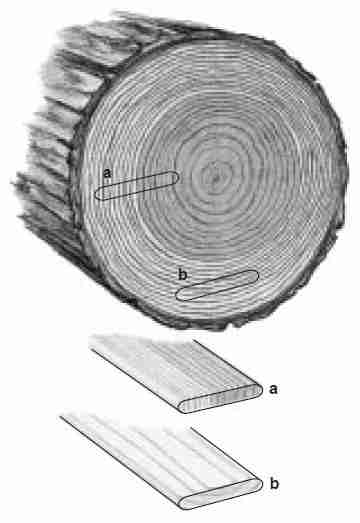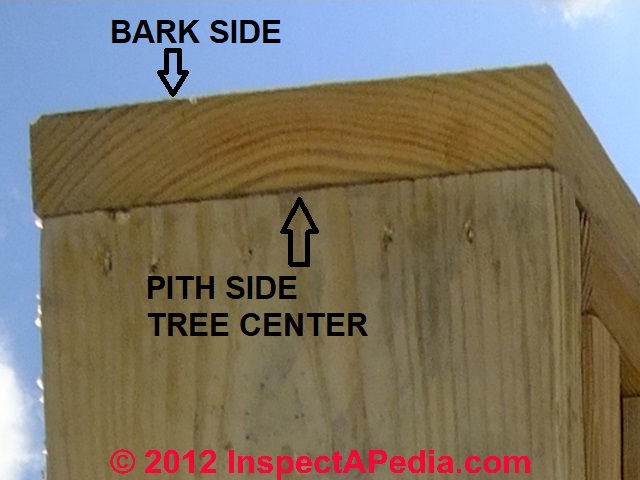 Bark Side Up Argument
Bark Side Up Argument
Why Should Wood Boards Be Placed Bark Side Up?
- POST a QUESTION or COMMENT about wood deck & porch construction: board cupping cause and prevention
Arguments for placing boards bark side up:
Why do some deck builders and contractors prefer to place boards and stair treads bark side up in outdoor construction?
This article series explains the causes of cupping in wood boards & wood board right side up advice for steps, decks, ramps, concluding which side of boards should face up or down (bark side down or bark side up in some cases) when building a deck or exterior wood stairs.
InspectAPedia tolerates no conflicts of interest. We have no relationship with advertisers, products, or services discussed at this website.
- Daniel Friedman, Publisher/Editor/Author - See WHO ARE WE?
Origins of the Bark-Side Up view of wood deck or stair board placement
Empirical Evidence for the Bark-Side Up View of wood deck or stair board placement
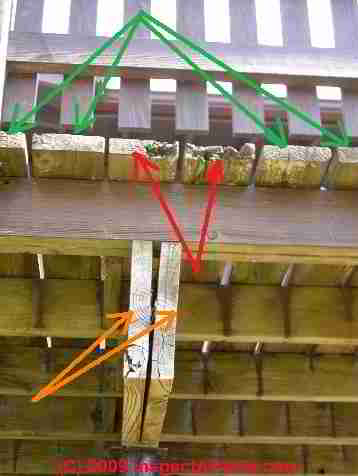
In Best Practices Guide to Residential Construction author Steven Bliss asserted, "always install trim [and outdoor deck boards and stair treads] “bark-side down,” since the annual rings try to straighten as the wood shrinks."
His view agreed with many wood experts but quite a few deck builders had a different field experience.
[Click to enlarge any image]
Those disagreed with the "bark side down" view so I asked Mr. Bliss for more help with this question.
In the text below we both, along with the US FPL came to the conclusion that the opposite approach : the bark side of deck and wood stair or ramp boards should generally face up, is correct - a change with which Mr. Bliss concurs - good research.
However plenty of wood experts argue about the direction in which flatsawn boards will tend to cup - views that we report and whose sources we cite in the article below.
If you click to enlarge the photo of an old, rotting deck structure at left you might notice the following very interesting details:
- Boards marked with green arrows:
most of the deck boards were placed bark side up, arched convex side up (slightly) and show less rot than the red arrow-marked boards. - Boards marked with red arrows:
the two most-rotted deck boards (red arrows, photo center) were installed with deck boards cupped upwards or "concave"; - Boards marked with orange arrows:
You can see the end grain in the two 2x12's forming the deck girder (orange arrows photo lower center). These two boards arched backwards from our anticipated curve pattern.
You'll see by the wood end grain pattern that the girder right-hand board has it's "bark side" facing right, and the left hand board has its "bark side" facing left. Both of these boards curved towards the "bark side" - an example supporting the "bark side down" wisdom when building an exterior deck or stair.
To understand why the orange-arrow-marked boards arched backwards, with the bark-side cupped (slightly) consider how these 2x boards were used. To form a girder the two boards were placed facing one another to form a sandwich. There was no top flashing to keep water (rain or snow) from entering the space between these boards.
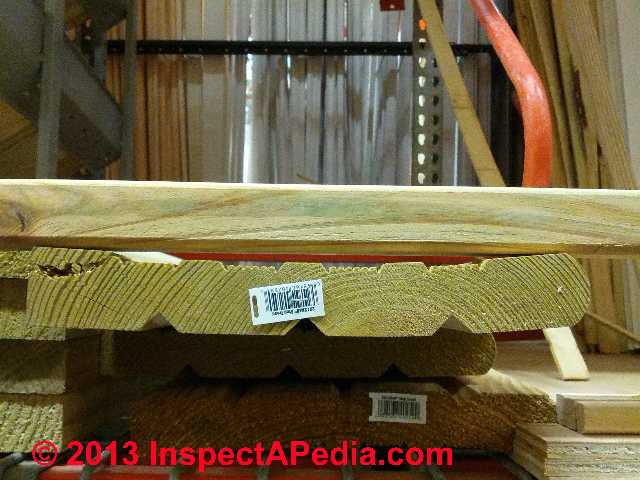 As a result, the space between the boards catches and holds water while the opposite side of the boards is exposed to more airflow.
As a result, the space between the boards catches and holds water while the opposite side of the boards is exposed to more airflow.
Therefore arching on the wetter side and cupping on the more dry side of these boards is quite consistent with our explanation of why boards cup in the first pace,
at BARK SIDE UP or DOWN on DECKS & STEPS? where we answer this question once and ... we hope ... for all.
Cupping with bark side convex occurs in some misbehaving boards
Watch out still further: while generally placed outdoors such as on a deck, the bark side of treated wood and much other wood arches "up" as the wood dries, as our photo at left illustrates, nobody has told any of the the boards or framing lumber that's what they are supposed to do.
The board shown in end-grain in our photo at left has its cupped concave surface towards the bark side.
See BARK SIDE DOWN ARGUMENT -the view of wood experts.
For any wood cupping rule you will on occasion find a board that behaves opposite to the usual rule.
The pre-cut pressure-treated wood stair step or tread in our photo (above left) is cupping "wrong way" arching towards the tree center rather than towards the bark side.
Therefore, if during construction of a deck, stair, or other wooden walking surface you see that a board is already significantly cupped in one direction, we recommend placing that board with the arch of the cup or the convex side facing up for better drainage.
Field Experience and Carpentry School Argued for "Bark Side Up" - place the arced wood-grain facing convex surface upwards
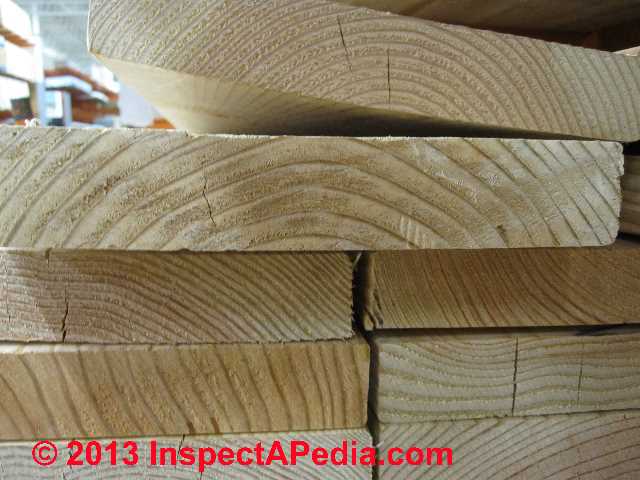 Question: isn't it better to place boards with the arc formed by tree growth rings facing "up" - that is, with the convex side facing up when building stairs or a wood deck deck walking surface ?
Question: isn't it better to place boards with the arc formed by tree growth rings facing "up" - that is, with the convex side facing up when building stairs or a wood deck deck walking surface ?
In carpentry school I [DF] was taught to always place 5/4 & 2x lumber wood stair treads with the wood grain arc visible at the end cut of the tread such that the arc faced "up" - that is bark side up.
An intuitive basis for this view is the simple observation that tree trunks are more or less round and that their bark is on the outside, the convex surface of the tree. It seemed natural that this same "round" or convex tendency would be innate in flatsawn boards cut from trees.
Bernie Campbalik, our instructor, opined that wood (at least exposed to outdoor conditions) tends to cup towards the center of the tree - backwards from the explanation previously published in some sources.
And when a piece of framing lumber was twisted (top board in our photo shown at left) we'd use clamps to force the board in place and we'd fasten it with screw-type connectors.
Or if a devil-board was too wild, we'd cut out shorter, usable sections, or in the worst case, it was used for firewood.
At the lumber yard Henry Page used to yell at me if he caught me sorting through the framing lumber for my deck, porch or stairs. "Ya ain' t building furniture" he'd shout. As a result, plenty of furtive sorting went on when the boss was not looking.

Bark side up on an exterior deck floor may balance tangential. wood shrinkage against the effects of high moisture on the rained-on side of boards, pitting one force against the other.
For a deck whose underside is likely to remain more wet than its upper surface you might prefer bark side down. .
Original sketch (left, edited with "corrected" text) and flipped sketch (right) adapted from the original sketch provided by S. Bliss, Best Practices in Residential Construction. Edited by InspectAPedia)
Indeed I [have built quite a few outdoor steps and decks and made a point of following Bernie's advice.
And when inspecting existing wood decks and steps outdoors (I've of course inspected many more than I could ever have built) in my OPINION I pay close attention to boards that are cupped.
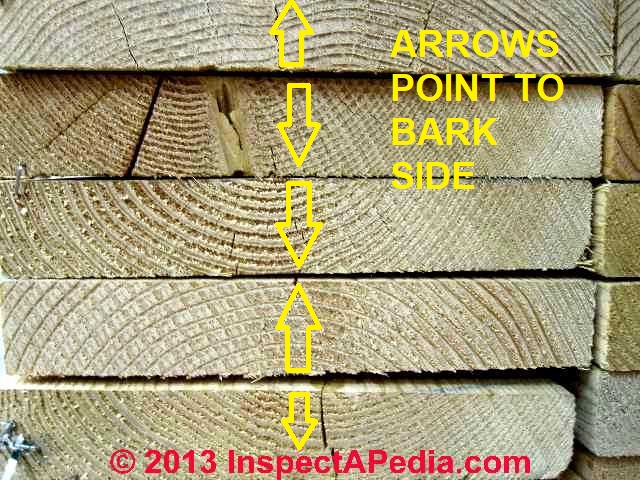 For those deck or stair tread boards whose end grain I could see, 9 times out of 10 my recollection is that the deck or step boards that were cupped (that is concave with a cup that tends to collect water with the cup up) had, by their end grain information, been placed bark side down - the "wrong way" in my book.
For those deck or stair tread boards whose end grain I could see, 9 times out of 10 my recollection is that the deck or step boards that were cupped (that is concave with a cup that tends to collect water with the cup up) had, by their end grain information, been placed bark side down - the "wrong way" in my book.
Cupped ramp, deck or exterior stair boards (or landing and platform boards) hold water and form algae or ice more quickly and for a longer interval than boards that drain properly.
They sometimes rot faster too.
Our photo (left) shows a stack of 2x lumber.
From the topmost board in the photo the 5 boards are facing 1-bark up, 2-bark down, 3-bark down, 4-bark up, 5-bark down. These are all flat-sawn boards.
When building a wood deck, ramp, or exterior wood stair treads, take a look at the end-grain of any deck, ramp, or wooden walkway board and notice the curved lines that mark the winter wood layers of the tree from which the board was cut
If these lines arch "upwards" (bark side up) when the board is placed, most boards will also be curved upwards (convex) and will drain better.
On occasion when inspecting exterior wood structure surfaces I found what I considered an exception to the "bark up" rule: a board that cupped in the "wrong way" - wood boards, having been made by mother nature, don't always follow the rules, but usually they do.
Steve: given these views, do you know of more research or do you have some experience or photos that shed light on my dim confusion? - Daniel Friedman
US FPL Support for Bark Side Up, Pith Side Down
My [S. Bliss] original bark-side-down advice was based on conventional wisdom, which, as you know, is often wrong. You obviously have far more empirical data to go on, so I’d go with your advice.
I remember we pitched this question to one of our wood gurus at JLC [Journal of Light Construction] who came to the conclusion after years of study and debate that you should ignore the bark issue altogether with exterior decking and “pick the best face and install your decking best-face up. Securely fasten the deck boards and apply an annual coating of water repellent.”
The wood gurus at FPL seem to support the bark-side-up approach, [38] more to prevent shelling and the exposure of untreated sapwood than to prevent cupping.
Cupping results from the shrinking of the top and swelling of the bottom of the wood, which are caused by exposure to moisture and drying by the sun. These changes do not occur evenly throughout the wood.
The amount of initial cupping depends on the difference between the moisture content of the wood at the time it is cut compared to the moisture content in service.
As the boards weather and continue to experience wetting and drying cycles, cupping continues to increase. The boards take on increased “set.”
Sketch at left illustrating the different log locations and wood grain properties of "edge grain" or "straight grain" wood (a) and "flat grain wood" (b) has been adapted from one provided by the U.S. FPL [38]
Even during periods of rain, when the moisture content rises in the surfaces, boards remain cupped because the surfaces undergo a permanent set.
During periods of increased moisture content, the surface cells are slightly crushed; during drying periods, small cracks (checking) appear in the wood because the surface cells remain crushed.
Vertical-grained lumber tends to have fewer problems with cupping than does flat-grained lumber, but both kinds of wood will cup when the top or outside of the wood is lower in moisture content than the opposite side. In the case of decking, the top of the board dries much faster than the bottom; in fact, water may be driven down by the drying process.
Water-repellent treatment also helps to keep the wood dry. In tests at the Forest Products Laboratory, the bottom of deck boards was about 2% wetter than the top. T
he better the water repellent, the greater the difference [in moisture absorption between the two sides of the board - Ed.]
Contrary to popular notion, there is only a small advantage to placing boards bark-side up with regard to cupping. - copy available at [38]
Two More reasons to place wood boards bark-side up: avoid shelling problems & improve preservative penetration
The same US FPL document continues with explanation of other reasons for placing wood with bark side up and pith side (tree center side) down:
1. However, it is advisable to place the bark-side up for other reasons.
The pith side is more prone to a severe type of raised grain, called shelling, particularly in species that have dense latewood growth rings, such as southern pine.
2. The second advantage to placing
deck boards bark-side up relates
only to wood that has been
pressure-treated with preservatives
and not incised.
Pressure
treatment does not penetrate the
heartwood of unincised wood very
well. In a flat-grained board, the
bark side may consist of 100%
sapwood and therefore be fully
penetrated with treatment,
whereas the pith side may contain
a portion of poorly penetrated
heartwood.
When the deck is
exposed to the weather, checking
of the heartwood surfaces can
expose the untreated heartwood
to attack by decay fungi.
The
bottom of the deck is not prone to
checking because its moisture content is less changeable than
that of the surface.
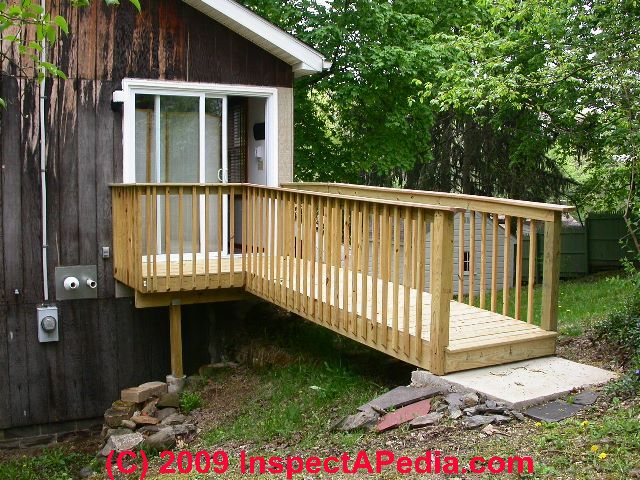 [The moisture level of the bottom of the deck or step boards is less changeable than the upper surface because while both sides may become quite wet in rainy or melting-snow conditions, the upper side of the deck or stairs in many locations gets direct sunlight and possibly more wind exposure as well.
[The moisture level of the bottom of the deck or step boards is less changeable than the upper surface because while both sides may become quite wet in rainy or melting-snow conditions, the upper side of the deck or stairs in many locations gets direct sunlight and possibly more wind exposure as well.
For example in the ramp and entry platform that we built and as shown at left, there is much less air circulation and no sun exposure on the under-side of this wood ramp. - DF.]
So I [SB] stand corrected and will install future decking bark side up – or more likely avoid the issue altogether and use bark-less composite materials.
Steve Bliss
Steve Bliss's Building Advisor at buildingadvisor.com helps homeowners & contractors plan & complete successful building & remodeling projects: buying land, site work, building design, materials & components, & project management through complete construction.
Exceptions to the Bark-Side-Up Rule for Placing Wood Boards on Steps & Decks/Ramps
Watch out: Don't follow this bark side up rule blindly.
Take a good look at your actual individual boards or stair treads when you are building an outdoor structure. If we are installing a deck board that is already rather cupped, we prefer to install it with the convex or "outward curve" side facing up for best drainage. The FPL wood surface chemists agree, commenting in the same document:
These factors, although important, can be overridden by a third factor—the quality of the pith side compared to that of the bark side. If the pith side is clearly better, place this side up.
Follow-Up: more support for bark side up.
 How interesting, thanks. I will solicit more data from readers too.
How interesting, thanks. I will solicit more data from readers too.
Our photo (left) illustrates a deck constructed by Paul Galow, more or less on-grade, in a shaded area, with minimal ventilation beneath.
We expect significant moisture differences between the hidden underside and the exposed top side of these deck boards. Photo courtesy Paul Galow.
Watch out: that green algae growing on the deck surfaces, when wet, is the slipperiest substance known - a serious fall hazard.
In my OPINION [DF], problems with relying on wood treatment to reduce wood cupping on steps and decks or ramps include:
- Treating just the up side leads to differential water absorption - often only the "up" side of wood is treated after construction
- Cupping may occur on unevenly-treated lumber as we see in both indoor and outdoor cupped flooring and boards - the more dry side of boards typically can be identified by center cupping in the board and board edges curling up.
- Realistic expectations: nobody is going to apply waterproofing treatment coating to decks, stairs, or ramps every year
- Good design IMHO is for what people actually do, not for what they should do.
...
Continue reading at BARK SIDE DOWN ARGUMENT or select a topic from the closely-related articles below, or see the complete ARTICLE INDEX.
Or see these
Recommended Articles
- BARK SIDE UP or DOWN on DECKS & STEPS?
- BUTT JOINT CURLING in FIBER CEMENT SIDING
- DECK & PORCH CONSTRUCTION - home
- FLOOR DAMAGE DIAGNOSIS
- SLIPPERY STAIRS, WALKS, ROOFS
- WOOD FLOOR DAMAGE
- WOOD FLOOR MOISTURE
Suggested citation for this web page
BARK SIDE UP ARGUMENT at InspectApedia.com - online encyclopedia of building & environmental inspection, testing, diagnosis, repair, & problem prevention advice.
Or see this
INDEX to RELATED ARTICLES: ARTICLE INDEX to BUILDING DECKS & PORCHES
Or use the SEARCH BOX found below to Ask a Question or Search InspectApedia
Or see
INDEX to RELATED ARTICLES: ARTICLE INDEX to BUILDING STRUCTURES
Or use the SEARCH BOX found below to Ask a Question or Search InspectApedia
Ask a Question or Search InspectApedia
Try the search box just below, or if you prefer, post a question or comment in the Comments box below and we will respond promptly.
Search the InspectApedia website
Note: appearance of your Comment below may be delayed: if your comment contains an image, photograph, web link, or text that looks to the software as if it might be a web link, your posting will appear after it has been approved by a moderator. Apologies for the delay.
Only one image can be added per comment but you can post as many comments, and therefore images, as you like.
You will not receive a notification when a response to your question has been posted.
Please bookmark this page to make it easy for you to check back for our response.
IF above you see "Comment Form is loading comments..." then COMMENT BOX - countable.ca / bawkbox.com IS NOT WORKING.
In any case you are welcome to send an email directly to us at InspectApedia.com at editor@inspectApedia.com
We'll reply to you directly. Please help us help you by noting, in your email, the URL of the InspectApedia page where you wanted to comment.
Citations & References
In addition to any citations in the article above, a full list is available on request.
- [1] The moisture content in wood varies depending on not only green un-dried lumber versus dried or kiln dried lumber, but also wood species, the ambient environment, and more.
Green lumber that has not been soaked by rain or floating down a river may still have moisture at 30% or above; and wet wood that has been soaked may have 2 1/2 times as much moisture as that same wood species when it has been dried or kiln dried.
Free water on or in wood dries quickly but bound water within wood cells takes much longer to dry or requires kiln drying or other measures for its removal. - [2] The fiber saturation point of wood or wood's FSP is defined as the moisture content of that wood when all of the free water has been removed. Picture the clothes in your clothes washer at the end of a spin cycle. The wet clothing has been squeezed until you couldn't get more water out of it - that clothing is at its fiber saturation point. And just as FSP varies among wood species, if you've ever done laundry you've noticed that some fabrics retain less water at the end of the washer's spin cycle than others.
- [3] Glen D. Huey, "Why Wood Warps", Popular Woodworking Magazine, 12 July 2012, retrieved 7/17/2013 original source http://www.popularwoodworking.com/article/why-wood-warps, reprinting from Woodworking Magazine, Summer 2009.
- [4] Terrie Noll, The Joint Book, Popular Woodworking Books, Cincinnati OH, www.popularwoodworking.com Quarto Publishing, , Inc., 2002, ISBN 1-55870-633-x
- [5] R. Bruce Hoadley, Understanding Wood, Taunton Press
- [6] U.S. D.A. Forest Products Laboratory, "The Wood Handbook",
- [7] Cloutier, Alain, and Yves Fortin. "A model of moisture movement in wood based on water potential and the determination of the effective water conductivity." Wood Science and Technology 27, no. 2 (1993): 95-114. -
Abstract: A model of isothermal moisture movement in wood during drying using the gradient in water potential as the driving force is proposed. The moisture transport coefficient used in this model is the effective water conductivity. It is a function of moisture content, temperature, and direction of flow. The boundary desorption curve of the effective water conductivity function is established in the radial and tangential directions of aspen sapwood from nearly saturated to dry conditions at 20, 35, and 50 °C using the instantaneous profile method.
The results show that the effective water conductivity increases exponentially with moisture content and temperature. The effect of temperature cannot be solely explained by the variation of the viscosity of water. The variation of the moisture content-water potential relationship with temperature would explain a large part of this effect. The effective water conductivity was generally higher in the radial direction than in the tangential direction in a ratio varying from 1/1 to 25/1 depending on moisture content and temperature. The flux-gradient relationship obtained at given moisture contents were found to be linear, confirming the validity of the model for the experimental conditions considered in the present work. - [8] Clarke, S. H. "The differential shrinkage of wood." Forestry 4, no. 2 (1930): 93-104. .oxfordjournals.org
- [9] Boyd, J. D. "Relationship between fibre morphology and shrinkage of wood." Wood Science and Technology 11, no. 1 (1977): 3-22.
Abstract: This is a study on the shrinkage of wood representing the wide range of morphology variation in leaning trees. It involved 13 trees of Eucalyptus regnans, one of Eucalyptus sieberi and four of Pinus radiata, and specimens taken at close intervals around the circumference of each. Data indicated a systematic modulation, between extremes at upper and lower sides of each stem, in longitudinal growth strains, relative proportions of thin, medium and thick-walled fibres, microfibril angle in the S2 layer of these, and both Klason and acid-soluble lignin content.
Analyses indicated that the microfibril angle in S2 was a prime factor in influencing both longitudinal and volumetric shrinkage reactions; proportion of thick-walled fibres in the tissue, thickness of S2 relative to S1, and variations in lignification also were involved. Unusually thick-walled fibres were associated with visco-elastic strain recovery effects, which could form a substantial part of dimensional changes apparently attributable to shrinkage. - [10] Gu, H., A. Zink-Sharp, and J. Sell. "Hypothesis on the role of cell wall structure in differential transverse shrinkage of wood." European Journal of Wood and Wood Products 59, no. 6 (2001): 436-442.
- [11] Barkas, W. W. "Wood water relationships, VI. The influence of ray cells on the shrinkage of wood." Transactions of the Faraday Society 37 (1941): 535-547.
Excerpting: " "The shrinkage of wood is not the same in the three directions of the grain. It is greatest in the tangential (7) direction where the shrinkage per unit change in moisture content dr/dm lies for most woods between 0-2 and 0.4. In the radial (p) direction dp/dm is usually about half this value, while in the longitudinal direction ... [shrinkage] is much smaller, amounting to about 1/50th of the tangential."
- [2] Decks and Porches, the JLC Guide to, Best Practices for Outdoor Spaces, Steve Bliss (Editor), The Journal of Light Construction, Williston VT, 2010 ISBN 10: 1-928580-42-4, ISBN 13: 978-1-928580-42-3, available from Amazon.com
- Steve Bliss's Building Advisor at buildingadvisor.com helps homeowners & contractors plan & complete successful building & remodeling projects: buying land, site work, building design, cost estimating, materials & components, & project management through complete construction. Email: info@buildingadvisor.com
Steven Bliss served as editorial director and co-publisher of The Journal of Light Construction for 16 years and previously as building technology editor for Progressive Builder and Solar Age magazines. He worked in the building trades as a carpenter and design/build contractor for more than ten years and holds a masters degree from the Harvard Graduate School of Education. Excerpts from his recent book, Best Practices Guide to Residential Construction, Wiley (November 18, 2005) ISBN-10: 0471648361, ISBN-13: 978-0471648369, appear throughout this website, with permission and courtesy of Wiley & Sons. Best Practices Guide is available from the publisher, J. Wiley & Sons, and also at Amazon.com - [38] Sam Williams and Mark Knaebe, "The Bark-Side/Pith-Side Debate", The Finish Line, (A Forest Products Laboratory finishing factsheet), December 1995, U.S. Forest Products Laboratory, retrieved 9/13/12, original source http://www.fpl.fs.fed.us/documnts/finlines/willi95b.pdf [copy on file as Bark_Side_Wood_FPL.pdf] R. Sam Williams and Mark Knaebe are researchers in Wood Surface Chemistry at the USDA Forest Service, Forest Products Laboratory, One Gifford Pinchot Drive, Madison, WI 53705–2398
- [39] Sarah Lyall, "Bark Up or Down? Firewood Splits Norwegians", The New York Times, 20 February 2013, p. A4.
- Eric Galow, Galow Homes, Lagrangeville, NY. Mr. Galow can be reached by email: ericgalow@gmail.com or by telephone: 914-474-6613. Mr. Galow specializes in residential construction including both new homes and repairs, renovations, and additions.
- Paul Galow [Website galowconsulting.com ] - technical consultant on networking, LAN design, applications support. Galow Consulting Services [Website galowconsulting.com ] , 914-204-1749, email: paulgalow@galowconsulting.com
- In addition to citations & references found in this article, see the research citations given at the end of the related articles found at our suggested
CONTINUE READING or RECOMMENDED ARTICLES.
- Carson, Dunlop & Associates Ltd., 120 Carlton Street Suite 407, Toronto ON M5A 4K2. Tel: (416) 964-9415 1-800-268-7070 Email: info@carsondunlop.com. Alan Carson is a past president of ASHI, the American Society of Home Inspectors.
Thanks to Alan Carson and Bob Dunlop, for permission for InspectAPedia to use text excerpts from The HOME REFERENCE BOOK - the Encyclopedia of Homes and to use illustrations from The ILLUSTRATED HOME .
Carson Dunlop Associates provides extensive home inspection education and report writing material. In gratitude we provide links to tsome Carson Dunlop Associates products and services.



